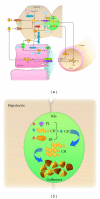Molecular Mechanisms Underlying the Link between Nuclear Receptor Function and Cholesterol Gallstone Formation
- PMID: 22132343
- PMCID: PMC3206498
- DOI: 10.1155/2012/547643
Molecular Mechanisms Underlying the Link between Nuclear Receptor Function and Cholesterol Gallstone Formation
Abstract
Cholesterol gallstone disease is highly prevalent in western countries, particularly in women and some specific ethnic groups. The formation of water-insoluble cholesterol crystals is due to a misbalance between the three major lipids present in the bile: cholesterol, bile salts, and phospholipids. Many proteins implicated in biliary lipid secretion in the liver are regulated by several transcription factors, including nuclear receptors LXR and FXR. Human and murine genetic, physiological, pathophysiological, and pharmacological evidence is consistent with the relevance of these nuclear receptors in gallstone formation. In addition, there is emerging data that also suggests a role for estrogen receptor ESR1 in abnormal cholesterol metabolism leading to gallstone disease. A better comprehension of the role of nuclear receptor function in gallstone formation may help to design new and more effective therapeutic strategies for this highly prevalent disease condition.
Figures

Similar articles
-
The effect of ursodeoxycholic acid on the relative expression of the lipid metabolism genes in mouse cholesterol gallstone models.Lipids Health Dis. 2020 Jul 2;19(1):158. doi: 10.1186/s12944-020-01334-3. Lipids Health Dis. 2020. PMID: 32615989 Free PMC article.
-
Triglycerides and gallstone formation.Clin Chim Acta. 2010 Nov 11;411(21-22):1625-31. doi: 10.1016/j.cca.2010.08.003. Epub 2010 Aug 10. Clin Chim Acta. 2010. PMID: 20699090 Review.
-
Pathogenesis of cholesterol and pigment gallstones: an update.Clin Res Hepatol Gastroenterol. 2011 Apr;35(4):281-7. doi: 10.1016/j.clinre.2011.01.009. Epub 2011 Feb 25. Clin Res Hepatol Gastroenterol. 2011. PMID: 21353662 Review.
-
Activation of Estrogen Receptor G Protein-Coupled Receptor 30 Enhances Cholesterol Cholelithogenesis in Female Mice.Hepatology. 2020 Dec;72(6):2077-2089. doi: 10.1002/hep.31212. Epub 2020 Oct 22. Hepatology. 2020. PMID: 32112420 Free PMC article.
-
Biliary lipids, water and cholesterol gallstones.Biol Cell. 2005 Nov;97(11):815-22. doi: 10.1042/BC20040088. Biol Cell. 2005. PMID: 16232124 Review.
Cited by
-
Effect and related mechanism of Yinchenhao decoction on mice with lithogenic diet-induced cholelithiasis.Exp Ther Med. 2021 Apr;21(4):316. doi: 10.3892/etm.2021.9747. Epub 2021 Feb 3. Exp Ther Med. 2021. PMID: 33717259 Free PMC article.
-
Gallbladder Stones in Pediatric Age: An Emerging Problem: The Risk of Difficult Cholecystectomy and the Importance of a Preoperative Evaluation.Children (Basel). 2023 Sep 13;10(9):1544. doi: 10.3390/children10091544. Children (Basel). 2023. PMID: 37761505 Free PMC article.
-
Protective Effects of Yinchenhao Decoction on Cholesterol Gallstone in Mice Fed a Lithogenic Diet by Regulating LXR, CYP7A1, CYP7B1, and HMGCR Pathways.Evid Based Complement Alternat Med. 2018 Sep 17;2018:8134918. doi: 10.1155/2018/8134918. eCollection 2018. Evid Based Complement Alternat Med. 2018. PMID: 30310412 Free PMC article.
-
Antilithiasic and hypolipidaemic effects of Raphanus sativus L. var. niger on mice fed with a lithogenic diet.J Biomed Biotechnol. 2012;2012:161205. doi: 10.1155/2012/161205. Epub 2012 Oct 3. J Biomed Biotechnol. 2012. PMID: 23093836 Free PMC article.
-
Gallstones.Niger J Surg. 2013 Jul;19(2):49-55. doi: 10.4103/1117-6806.119236. Niger J Surg. 2013. PMID: 24497751 Free PMC article. Review.
References
-
- Marschall HU, Katsika D, Rudling M, Einarsson C. The genetic background of gallstone formation: an update. Biochemical and Biophysical Research Communications. 2010;396(1):58–62. - PubMed
-
- Carey MC, Paigen B. Epidemiology of the American Indians’ burden and its likely genetic origins. Hepatology. 2002;36(4 I):781–791. - PubMed
-
- Lammert F, Miquel JF. Gallstone disease: from genes to evidence-based therapy. Journal of Hepatology. 2008;48(supplement 1):S124–S135. - PubMed
-
- Apstein MD, Carey MC. Pathogenesis of cholesterol gallstones: a parsimonious hypothesis. European Journal of Clinical Investigation. 1996;26(5):343–352. - PubMed
LinkOut - more resources
Full Text Sources
Miscellaneous

